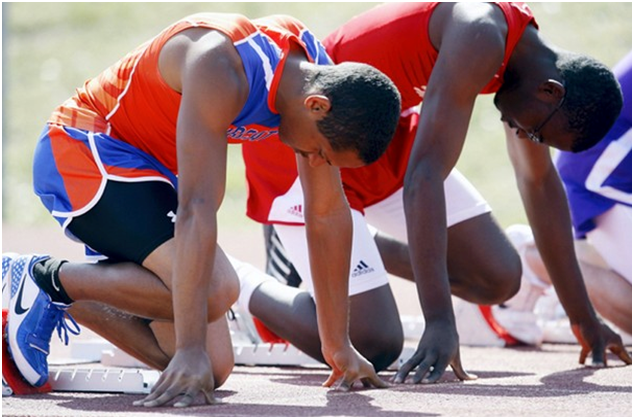|
How to Approach the Start of a Race
 Call-Up The call-up—the time before the race when you report and get your lane assignment—varies among events. To make sure you are fully prepared, you need to take two things into account. First, always time your warm-up to allow time for the call-up. You don't want to be rushed and have to scramble to get to your race. This also adds consistency to your pre-race prep, so there are no surprises that take you out of your groove. Second, use the call-up area as a place to relax and recover ahead of the race. You are warm from your warm-up, so you might want to put on a track jacket and some pants to prevent your body from cooling down. Starting Line When you approach the starting line, focus only on the upcoming race. Free your mind of all thoughts other than how you will run the race. Nothing else exists. Set up your blocks and check them to make sure they are comfortable. As you strip off your layers, run the race in your mind. Think about how you will run and how it will feel. Mimic your breathing patterns and relax your jaw and facial expression. This is not the time to size up your competitors. To Practice or Not to Practice I know from attending many events at a variety of levels that it is unusual, but my athletes rarely practice starts on the race line. The reasons are twofold: they have practiced block starts many times in training and know exactly what they need to do; and they have already performed at least seven starts during their warm-ups. So there's no reason to repeat it on the track start line. Sprinting relies heavily on the ATP-CP energy system in the first stages of a race. This system is slightly depleted even during low-intensity practice runs. After using this energy system, it takes three to five minutes to completely restore.
On Your Marks When the starter is ready, he will ask you to stand three meters behind the start line. When you hear "on your marks," immediately move toward the line. From this point on, your routine should never vary. You must do everything exactly the same as every single start you do in training. I recommend performing two explosive Tuck Jumps. This primes the central nervous system for exploding off the blocks. Shake your arms and legs to relax the muscles. A relaxed muscle is a fast muscle. Walk to about one meter in front of the blocks and squat down with your hands on the ground. Put one foot into the front block and the other foot in the rear block. You will be in an elongated position. Put the knee of your rear foot on the ground and raise yourself to an upright position without taking your feet out of the blocks. Now is the time to finally compose yourself. Look down the track at where you are going to end up or where you are going to apex the bend. Brush any grit or dirt from your hands, adjust your clothing and get comfortable. Place your hands one at a time inside the line. Get your positioning right so you don't need to adjust in the set position. Make sure your shoulders are directly over your hands, and your head, neck and spine are in a straight line. Your arms should be straight but not locked, and your elbows slightly wider than shoulder width. Put your weight on your fingertips and looks three to four meters down the track. Sway lightly from side to side until you are fully ready for the starter to call "Set." Set As stated above, once you are in the correct set position, there is nothing else to do. On set, move your hips up about two inches higher than your shoulders. Keep your back flat and look about .5 meters in front of the start. Do not focus on the sound of the gun. If you have practiced, you will react to it naturally. |
|
|







